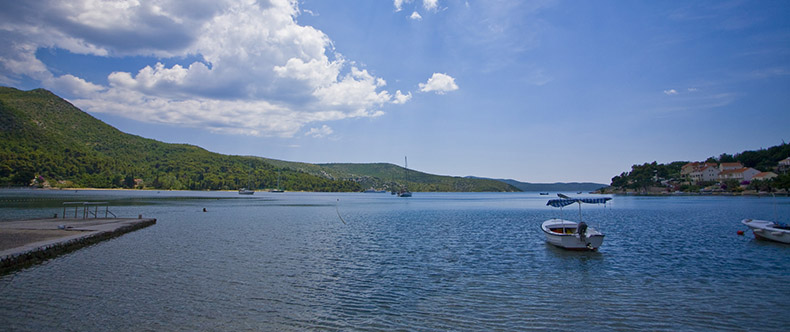It's about 2:30 p.m., Wednesday, September 26, 2018, and I'm in the town of Slano on the Dalmatian coast of Croatia.

Popular sailing destination Slano Bay is located on the Dalmatian coast of Croatia. Photo by Mike Norton/Flickr Commons
BY CAPTAIN RAY
Published: November, 2018
It’s about 2:30 p.m., Wednesday, September 26, 2018, and I’m in the town of Slano on the Dalmatian coast of Croatia. The bora has been blowing for the past two days. For thousands of years, the winds in the Mediterranean have been named based on the direction from which they come. The cold mistral from the northwest, the hot, dry sirocco from the south, and the warm levant from the east are examples of these famous winds. What I’m experiencing now is a cold, gale-force wind from the northeast, or bora.
I’m on a sailing trip from Split to Dubrovnik as part of a trip arranged by my sailing school. Nine boats departed Split on Sunday and slowly spread out among the many islands that line this coastline. We had two weeks to enjoy these islands and make our way to Dubrovnik, about 120 miles to the southeast. To increase the social aspects of our cruise (as well as the possible need for mutual aid), my crew and I had decided to “buddy boat”—or sail with another boat. During the first week the winds were quite light, and as is so often the case with sailors, we kept wishing for more wind. What we weren’t heeding was the ancient admonition “be careful what you wish for”—or the old Romani curse “may your wishes come true.” At the beginning of the second week, our wishes did come true in the form of the bora.
We’d been monitoring weather on a daily basis, of course, and the arrival of the bora on Monday afternoon was forecast days in advance. With winds predicted to be in the 40- to 50-knot range with gusts to 70 knots, we began examining the charts for a place to hide. Since we anticipated having to remain at whatever location we selected for several days, easy access to the shore and its restaurants was a priority. We did not want to be at anchor with the risk of it dragging and only way to get ashore a very dangerous and wet dinghy ride.
Although the winds were forecast to be very strong, it is rarely the wind that breaks boats. Damage is caused by the large waves generated by that intense wind. There are three factors that determine the size of waves: (1) the strength of the wind, i.e., the stronger the wind, the bigger the waves; (2) the duration of the wind, i.e., the longer the wind blows, the bigger the waves get; and (3) the “fetch,” or the distance travelled by the wind across open water before it reaches you. The only one of those three parameters under our control was the third one.
Therefore, what we were seeking was protection from a very strong northeast wind and the large waves it can generate, either in a marina or tied stern-to to a town quay (called Mediterranean or Med mooring) with the wind coming from the land and holding us off the dock or quay. We found what we needed in the town of Slano and headed for it.
Early in my training, a very wise skipper taught me that when bad weather is coming, a captain should plan to be where she wants to wait it out and have all her storm preparations completed one day before the bad weather’s forecast arrival. As she used to say, “In the next 24 hours everyone else will want to be where you already are.” We arrived Sunday afternoon (the bora was forecast to begin Monday afternoon) and docked. We then doubled all lines, removed everything from the deck that could blow away, added a lashing to the sail cover and waited. When the bora arrived, the wind did not build up gradually as is usually the case with storms. Instead, it went from eerily calm to 45-50 knots almost instantly.
That sage advice and the plan based on it worked perfectly. The next morning, the marine radio had numerous requests for berthing from boats seeking shelter. In some cases, they were turned away. In the afternoon we heard several mayday broadcasts. While we felt concern for fellow sailors, we couldn’t help also feeling a bit smug.
Ray Wichmann is a US SAILING-certified Ocean Passagemaking Instructor, a US SAILING Master Instructor Trainer, and a member of US SAILING’s National Faculty. He holds a 100-Ton Master’s License, was a charter skipper in Hawai’i for 15 years, and has sailed on both coasts of the United States, in Mexico, the Caribbean and Greece. He is presently employed as the Master Instructor at OCSC Sailing in the Berkeley Marina.

